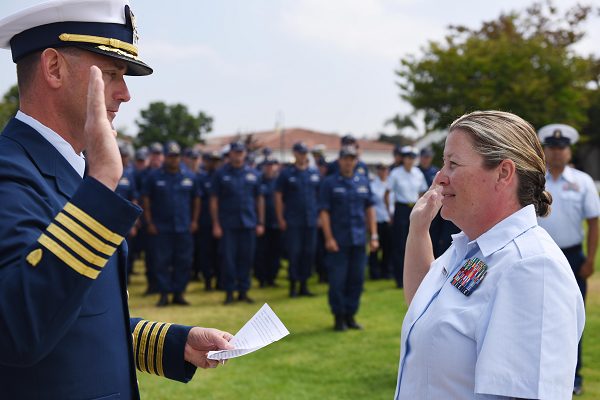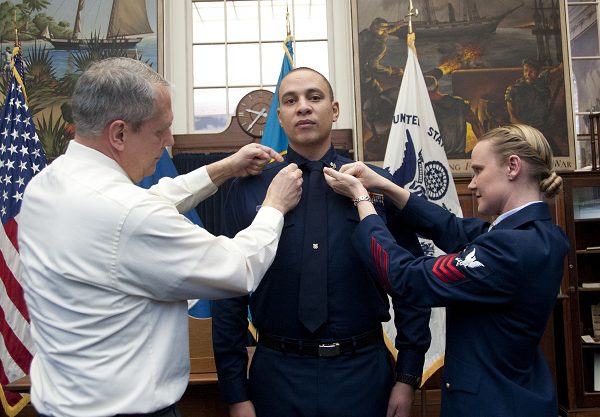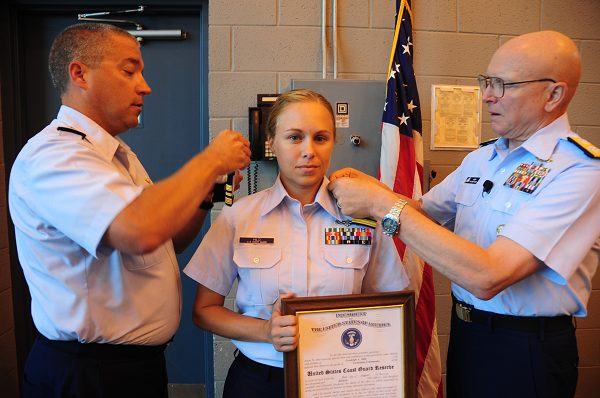To understand the Coast Guard promotion timeline, you first must know the Coast Guard ranks have four different categories.
These categories include enlisted, petty officers, warrant officers, and commissioned officers.
Also, the Coast Guard is part of Homeland Security during times of peace, but if we are at war, they become a part of the Navy.
Furthermore, the Coast Guard uses a letter and a number to show the ratings and pay grade, and rank is different than a Seaman’s pay grade.
Also, a Seaman’s rank relates to responsibilities in the Coast Guard.
Related Article – Coast Guard Basic Training Guide
Coast Guard Promotion Timeline for Enlisted Ranks

Enlisted promotions are based on merit.
Therefore, enlisted members take a Service Wide Examination (SWE) for eligibility and receive a raw score.
Afterward, this raw score is combined with other scores, such as your recent evaluation, time spent in service, your current rank, as well as points for any medal or awards you have.
All the scores are calculated together, and those eligible for the promotion are on a list starting with those with the highest scores.
Therefore, the calculation of scores is the service-wide competition where your promotions are based on your accomplishments.
Lastly, open positions are filled by those at the top of the list first.
Seaman Recruit (E-1)
A Seaman Recruit is an entry-level rank for members just joining the Coast Guard.
Seaman Apprentice (E-2)
To move up in rank to a Seaman Apprentice, you must complete Coast Guard basic training and have a recommendation from the commanding officer.
Seaman (E-3)
To become a Seaman, you must have six months as an E-2 or complete your ‘A’ course.
Related Article – Military Age Limits for 2020
Coast Guard Promotion Timeline for Petty Officers

Petty Officers have a growing set of responsibilities for those under them, as well as performing their own duties.
Petty Officer Third Class (E-4)
Promotion to Petty Officer Third Class is based on basic requirements such as six months of time in rating (TIR).
Also, members must complete their ‘A’ school or their on-the-job training program, if they have not done so already.
They must also have completed the Apprentice Leadership Program (ALP) prior to advancement to E-4.
Furthermore, you must have approval from your commanding officer (CO).
Petty Officer Second Class (E-5)
To become a Petty Officer Second Class, you need to fulfill your basic requirements, such as the SWE and the CO’s recommendation.
Also, you need six months of TIR.
Petty Officer First Class (E-6)
To become a Petty Officer First Class, you must have 12 months as an E-5.
Furthermore, you will need your CO’s recommendation and completion of any schools related to your rating.
Finally, your promotion depends on how you score in the SWE.
Chief Petty Officer (E-7)
Moving from an E-6 to an E-7 requires 24 months of TIG.
Also, the same requirements regarding schools for the rating, recommendations, and service-wide scores apply.
Senior Chief Petty Officer (E-8)
To become a Senior Chief Petty Officer, you need 24 months TIG.
Also necessary are the same basic eligibility mentioned above as well as the completion of the Chief Petty Officer’s Academy or other academies offered by the Department of Defense.
Master Chief Petty Officer (E-9)
Recently the Coast Guard announced the Master Chief Advancement Panel (MCAP) for advancement to an E-9.
Therefore, the MCAP replaces the SWE.
However, basic requirements, such as CO recommendations, still apply.
Also, TIG requirements are 24 months, as well.
Coast Guard Promotion Timeline for Warrant Officers
Warrant Officers are appointed by the Commandant of the Coast Guard. The ranks of Coast Guard Warrant Officers include Chief Warrant Officers W-2 through W-5. The Coast Guard does not use the W-1 rank.
Coast Guard Warrant Officers are promoted by a board that meets specifically to award promotions. The number of available promotions is determined by the Commandant and based on the needs of the service.
The promotion zone for Coast Guard Warrant Officers who have at least three years in their current grade by the middle of December of that year.
If previous selection boards have successfully awarded the member a promotion, Warrant Officers can expect to pin on their next pay grade approximately four years after they pinned on the last one.
Related Article – Navy Officer Candidate School Guide
Coast Guard Promotion Timeline for Officers
Officer candidates go through training designed just for officers.
Therefore, if you have a bachelor’s degree, you might consider entering the Coast Guard through the Officer Candidate School (OCS), which is a 17-week course.
After you graduate, you will receive a rank as an O-1, and you can expect to serve at least three years.
Although, another option is a Direct Commission Officer program.
If you have specialized education and experience, you should talk to a recruiter about officer opportunities.
Officer promotion information is not widely published for the Coast Guard; however, Officers are not guaranteed promotions.
The number of commissioned officers in any rank is set according to a percentage of the total active duty force.
Then, a selection board meets at least once a year to evaluate officers to determine who is fit for promotion.
However, the board has a set of criteria they use depending on the rank of which they need candidates.
Therefore, there are four basic areas of consideration:
- Evaluations of performance
- Education
- Professionalism
- Leadership
There are several officer ranks in the Coast Guard.
Ensign (O-1)
This is the lowest rank for commissioned officers in the Coast Guard and holds the pay grade O-1.
Ensigns are eligible for promotion to Lieutenant Junior Grade (O-2) after serving 12 months active service. They also require a recommendation from the selection board and the approval of of the Commandant.
Lieutenant Junior Grade (O-2)
In order to be considered for a promotion to Lieutenant by the selection board, the service member must have 3 years of service in the rank of Lieutenant Junior Grade.
They also require the recommendation from the selection board and Commandant’s approval.
Lieutenant (O-3)
For a promotion to Lieutenant Commander, the officer must have served 4 years on active duty in the rank of Lieutenant.
A recommendation from the selection board and Commandant’s approval is also required.
Lieutenant Commander (O-4)
For promotion to O-5, a Lieutenant Commander must serve 4 years in their current grade before consideration by the board. They will also require approval from the Commandant.
Commander (O-5)
Commanders must have 4 years time in grade to be considered by the selection board for the rank of Captain (O-6). The Commandant must approve the promotion as well.
Captain (O-6)
Captains must spend 3 years in pay grade O-6 for consideration by the selection board for promotion to Rear Admiral Lower Half. This promotion also requires approval from the Commandant.
Flag Officers
Higher ranks are recommended for promotion by the selection board, promoted by the President, by the advice of the Senate, and announced by the Commandant.
These ranks are considered Flag Officers and are as follows:
- Rear Admiral Lower Half
- Rear Admiral Upper Half
- Vice Admiral
- Admiral
- Fleet Admiral
FAQ
Are There Opportunities for Advanced Promotions in the Coast Guard?
Advanced promotions are available for those who have college credits or participate in JROTC.
Also, Eagles Scouts and Civil Air Patrol programs will earn you an advanced promotion after the completion of boot camp.
Furthermore, if you have prior military service, you can expect an advanced rank.
How Often Are Officers Considered for Promotion?
Officers with a rank of O-1 and O-2 have evaluations bi-annually.
O-3 and above have annual reviews by their supervisors with an officer evaluation report.
Conclusion
The Coast Guard has different categories of rank.
Promotions in the Coast Guard are based on merit.
Therefore, members take an eligibility exam.
Also, a service member earns points for accomplishments as part of the service-wide competition.
Those with the highest points are higher up on the list of promotable service members.
Eventually, there are vacancies in the Coast Guard, and those higher on the list receive their promotion.
Warrant Officers are appointed.
Commissioned officers are not guaranteed a promotion, as they are based on who is the fittest for the promotion.
References:
- Replacing Dog Tags: 6 Things You Need to Know - June 28, 2024
- Navy OAR Test Study Guide - June 24, 2024
- 10 Best Sniper Movies of all Time - June 20, 2024
Originally posted on July 10, 2020 @ 1:43 pm
Affiliate Disclosure: This post may contain affiliate links. If you click and purchase, I may receive a small commission at no extra cost to you. I only recommend products I have personally vetted. Learn more.

